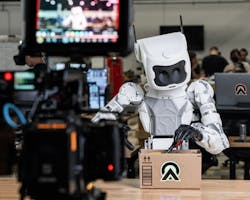A spin out of the Human Centered Robotics Lab at the University of Texas at Austin, startup Apptronik has some serious R&D behind it. Two of the company co-founders were part of NASA’s Johnson Space Center Valkyrie team, working on the actuators and controls of the humanoid robot, as well as participating in the DARPA Robotics Challenge to build a versatile “hero robot” that could do all the things needed in a disaster relief scenario.
These projects became advanced R&D work to eventually commercialize a more versatile robot that fills the need of working in an environment of unstructured tasks. And, despite the look of the robots the company has in its portfolio—like Astra, an upper body humanoid robot designed to operate with and around humans on a mobile platform, and Draco, a biped designed for agile dynamic walking—the company says it’s solving a huge problem in manufacturing.
“In manufacturing there are structured and highly repeatable tasks. Where we see this going is robots [designed] for the unstructured world,” said Jeff Cardenas, Apptronik co-founder and CEO. Specifically, Apptronik is building a platform where general purpose robots can accomplish a wide range of things vs. the typical one or two repetitive tasks. To do that, “you have to build new robots in new ways that are designed for more variable environments and variable activities for the unstructured world. That’s what we’ve done at Apptronik.”
Since 2016, Apptronik has been creating next-gen actuation and motion control as well as exoskeletons, and has figured out how to make an affordable robot that is energy efficient, more capable, and works safely around humans. This provides the foundation for what Apptronik calls “mobile manipulation.”
In robotics, the capabilities range from fixed robotic structures anchored to a floor, wall or ceiling to manipulate objects to autonomous mobile robots (AMRs) that can go nearly anywhere but not directly manipulate anything on their own. The goal is to combine these capabilities to create a mobile robot that can manipulate its environment. “Everything we’ve done in the last several years has been in the mobile manipulation space, which we saw as the next big wave,” Cardenas said.
So, the focus here is to build a general purpose system that can do a range of things. What’s happening in robotics now is much like the early days of the computer industry, where there were special purpose chips and computation before a move to a general purpose hardware platform that could support a variety of software applications. This general purpose platform allowed computers to scale.
“The same thing has to happen for robotics to scale,” Cardenas explained. “To get toward wider adoption we need general purpose hardware platforms that can have a variety of applications on top. Think of it as an iPhone of robots. One hardware platform with an ecosystem of developers. This is the next frontier.”
The Apptronik development platform provides a ‘system of systems’ approach. Right now the company is building the full technology stack to prove out the utility of the platform, but the future will include a range of developers building different applications.
So why the humanoid form factor? Cardenas said it’s because most of the workflows are designed around humans. So you start to move towards human proportions and human scale. “For me it’s about utility. It’s about a world that is built for humans already, everything from where handles are placed to the tools we use, the ergonomics are built around the human form,” he said. “And when you have a major labor shortage, if you want a general purpose robot to help alleviate some of that, you start to approach human form.”
To that end, Apptronik recently announced a partnership with NASA to scale and deliver production- grade systems to the market. The robot, called Apollo, is a general-purpose humanoid designed to work alongside people in supply chain and logistics applications, as well as healthcare, hospitality, and more.
According to Cardenas, “We’re taking what both teams learned from working on these systems for over a decade and applying that to build one of the first commercial humanoid robots that’s available.” The goal is to put it in a variety of environments—including space. “[NASA] wants to prove out terrestrial applications of general purpose robots to get the technology mature to the point that they then can plan space missions.”
There are currently pilots happening now with Apollo, which will have its public debut in March of 2023.

